Nuevo South
"Taking the Place of the Blacks"
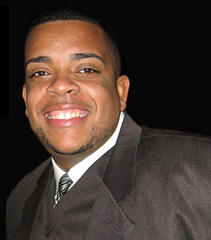
Siler City resident Calvin Dark embraces the diversity of his home town, but recognizes there is still tension between blacks and Latinos.
Courtesy Calvin Dark
Calvin Dark orders the quesadilla de pollo in effortless Spanish.
"With arroz," Dark says.
Dark is 29, a graduate of Duke University and a fluent speaker of Spanish and Arabic. He lives in Washington, D.C. and works for the Moroccan government, but he grew up in Siler City and his ties to the town are deep and powerful. "Because my family is here. All of my family, on my mother's side and father's side."
We talk over lunch at San Felipe, possibly the most popular Mexican restaurant in Siler City. It's part of a strip that includes a relatively new Wal-Mart on the highway leading out of town.
Dark remembers bringing his older African American relatives to San Felipe back around 2000, when he'd returned home after studying in Argentina.
"I wanted to practice Spanish," he recalls, "so the first thing I did was to tell my parents I wanted to eat Mexican. They were not that excited about it at first because they'd never had Mexican food, they didn't know what it was."
Dark coaxed his parents into the restaurant, and of course, to their surprise, they "loved the food. That was a few years ago. Coming to a Mexican restaurant to get fajitas or quesadillas, it's not ... exotic anymore."
Dark argues many Siler City natives, black and white, had experiences similar to his parents'. "That's why I think this restaurant and several others have done a lot to just kind of like just open up the culture, to let people in Siler City know, you know, [Latino] people eat just like we do here."
But African Americans and Latinos have often eyed each other warily in Siler City, Dark says.
He takes us to what he calls the Dark Side, a modest neighborhood of small houses and mobile homes tucked among trees in east Siler City. He stands in his aunt's front yard and points at half a dozen homes within sight along a couple of curving streets.
"Just over there is my grandmother's house, which my father and my uncle Jimmy built. My aunt Naomi's house is right next door.... And my Aunt Pookie's house is there. Next door to hers is my Aunt Betty's house...." The house Calvin grew up in, and where his mother still lives, is just up the road.
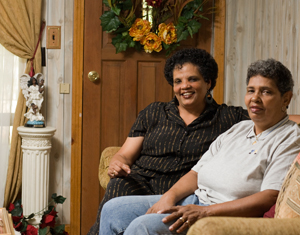
Calvin Dark's aunts, Susan Alston and Zylphia ("Pookie") Dark. "I understand the reason why they are coming," says Zylphia Dark about the new Latino population.
Photo by DL Anderson
The Darks are related to the black Silers, descendents of the slaves owned by the family after whom the town is named. The family was among the founders of a leading black church in town, First Missionary Baptist, early in the 20th century.
"We have all just been there all our lives," says Calvin's aunt, Susan Alston, "just as a hand-me-down family."
"Black people felt that we had a place here," says Calvin Dark. "Some parts of it were good and some were not good." Dark's older relatives grew up in the demeaning culture of the Jim Crow South. "My mother never went to an integrated high school. But it was a definite place. I've never felt anything but at home here. But having another group come in? It was very tense. Very tense."
Sitting on a couch in Susan Alston's house, Alston and her sister, Zlyphia Dark, engage in a debate that captures the complicated relationship between Southern blacks and their new Latino neighbors.
63-year-old Zylphia Dark, who's known in her family as Pookie, recently retired as a government inspector in the poultry plants, "so I worked with the Latinos. They are hardworking people, and I understand the reason why they are coming, because [there's] no work [in their home countries], and if they were poor like I was growing up, I can understand. Trying to feed your family, you'll about do anything."
Pointing to the back-breaking work that Latino workers perform in poultry plants, Zylphia argues that "the Latinos are really taking the place of the blacks, what we used to go through. But I'm a believer [that] God made us and loves us all. And I try to treat people the way I want to be treated."
Zylphia's younger sister, Susan Alston, disagrees. "We look at the Hispanics as coming in because of their lack of necessities from Mexico. But then I ask myself, could we in turn do the same? If we were to want to move to Mexico just by flood?"
And what of the Haitian boat people, Alston asks, who were "left out in the sea to drown. Do America want to answer why did we accept one race and just totally send one back? Was it by color?"
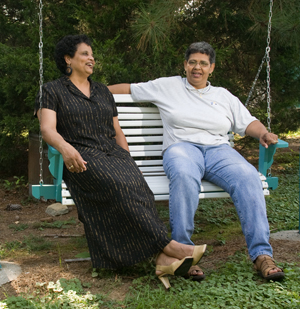
Alston and Zylphia Dark. The Hispanics, says Alston, "stepped into a place that we still haven't arrived at."
Photo by DL Anderson
Alston says it's true that "all of us are human. But to see [Latinos treated with] the ... rights that I never had in high school, to just be able to go into a store without feeling the oppression of I'm taking something or I'm being watched.... I don't hate the Hispanics. I just think they stepped into a place that we still haven't arrived at in 2008."
In conversations about the relative slices of pie claimed by blacks and Latinos, it's understood, and rarely needs to be stated, that whites still own the pie. While Siler City has some black elected officials and its first black police chief, political and economic power are concentrated in the hands of whites, who are now a minority in town.
Still, when Paul Cuadros reflects on the resentment expressed by some African Americans about the perceived acceptance of Latino immigrants, he confesses to feeling some sympathy for whites.
"It's kind of like a no-win situation for them," he says. "If they've learned anything from the civil rights movement, from the history with African Americans ... and then [apply] those things that they've learned to this new group of Latinos, then it feels like to African Americans that they're being stepped over, that 'You didn't treat us that way and now you're treating them that way.' ... So what are whites and Latinos supposed to do? Recreate this history all over again, of oppression and misunderstanding? Or really learn from the history that's happened, of race relations in the U.S. and the South?"
Political Muscle
On April 10, 2006, almost exactly six years after David Duke's ragtag rally in Siler City, the town hosted a far larger political demonstration, and one far more striking in historical terms. In response to Congressional inaction on immigration reform, Latino activists organized protest marches in cities across the country. In North Carolina, one of the largest was held in Siler City.
"The David Duke march maybe had 200 people there," says radio station owner Barry Hayes. "This one had over a thousand people, maybe 15 hundred people."
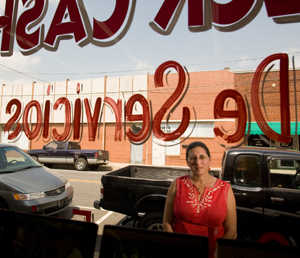
Ilana Dubester of Hispanic Liaison, who helped organize the pro-immigration rally.
Photo by DL Anderson
Ilana Dubester of Hispanic Liaison, which was instrumental in organizing the event, places the number far higher. "We figured there were about ... five, six, seven thousand people," many from other North Carolina towns who decided to descend on Siler City.
Throngs of Latinos and other supporters of immigration reform walked peacefully through the city streets, chanting "Si, se puede!" (Yes, we can!) before gathering in front of city hall for speeches and cheers.
"It wasn't an angry event," says Dubester, who spoke at the rally. "It was really about immigration reform and solidarity. And a lot of people spoke, a lot of African American leaders spoke and a lot of people walked up to the mic and asked to speak."
Still, some people in town, white, black, and even Latino, say the march was a setback for improved relations - that it came across as an intimidating show of force.
"I think the town just felt like this was the wrong way to go about getting something," says Hayes. "[That] if you wanted to ask for something or gain the favor of the community, that they were just going about it in totally the wrong way."
Told of such comments, Dubester is unapologetic. "Tough sh__," she says flatly. "I mean, that's what it was about.... It's OK if we're invisible, it's OK if we're silent, it's OK if we hide in our houses, it's OK if we break our backs and twist our hands cutting your fricking chicken. But for us to stand in front of your town hall demanding better services, demanding a better life and a better future, that's too much. 'You brown people stepped out of your place.' Yeah. We want a new place. Look how many of us are here. We have power in this town. We don't actually have power, in terms of representation or anything, we don't have, right? But look what's happening and look what we can do."
Acceptance?
"When I talk about those five stages, you know, this is really dealing with the loss of the culture," says Cuadros, meaning, the loss of a culture dominated by a white, or Anglo, majority. "The culture's changing. And that's what makes this issue so volatile."
The last of the stages of grief, after denial, bargaining, anger, and depression, is acceptance. "I don't necessarily think that Siler City is totally there," Cuadros says. "But it's certainly not as angry as it used to be."
It's often in schools that America's racial tensions, and progress, play out. Siler City is no exception. School officials are quick to acknowledge that a substantial fraction of white parents have fled the Latino influx by moving their kids into a largely-white charter school. At the same time, many other families, of all races, have stayed in the public schools, and the town opened a second elementary school in 2007 thanks to the swelling school-age population brought about by Latino immigration. That school, Virginia Cross Elementary, is more than 70 percent Latino.
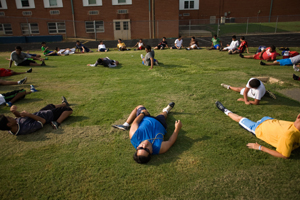
Cuadros and his boys' soccer team. High school sports have been both a source of conflict and a place for Siler City residents to find common ground.
Photo by DL Anderson
School sports, too, have served as a cultural bridge between longtime residents and Latino newcomers, say many people in Siler City. "The most visible part of [a] school is on its athletic fields," Cuadros says.
Cuadros faced stiff resistance from school officials in the late 1990's when he first proposed creating a soccer team at Jordan-Matthews. Soccer is popular at many urban and suburban schools in North Carolina, but "Siler City's a real football town, a very traditional sports town," Cuadros says. In a town devoted to football, basketball and baseball, soccer seemed almost alien. "I had never really brought it up as being an outlet for Hispanic students," says Cuadros. "It was always to be a program open to anyone who could play. But it was quickly seen as something for the Latino students at the school."
The school principal offered "a litany of excuses" for not creating a team, Cuadros says, despite petitions from students who wanted to play. There was "no place for them to practice, no place for them to play. They were not going to be able to play on the football field. There were no resources to buy equipment for the team. There weren't enough kids academically eligible to play on the team."
Cuadros raised funds for equipment, lined up a coaching staff, led by himself, and helped some of the team's would-be players raise their grades. Still the answer was no. "At that point it seemed to me that the answer was always going to be no."
But Cuadros found a key ally on the county commission, who spoke to the superintendent. Meanwhile, the school got a new principal who was more sympathetic. Cuadros sought backing in the business community.
He "came to our Rotary," recalls John Pleasants, a Siler City native and Jenny Pleasants' husband. "And some more people got involved and they decided to go ahead and start a soccer team and let the field be used."
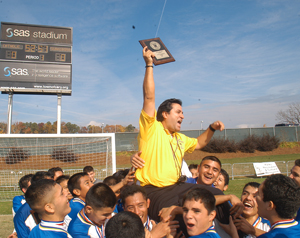
Cuadros led his boys' soccer team to a state title in 2004.
Courtesy Paul Cuadros
As he recounts in his book, Cuadros led his boys' Jordan-Matthews team to the small-school state title in 2004, just the third year of the team's existence. That Christmas, the mostly Latino team rode through town in the Christmas parade.
"It was real big," Cuadros says of the championship. "It really helped open people's minds that if you give these kids a chance and a level playing field, they could compete against anybody. It also got the long-term residents to look at these kids as one of their own.... These kids were not just Latino kids. They were Jets."
Now, says John Pleasants, sitting in the bleachers and watching his daughter's last game at Jordan-Matthews, there's "great involvement" in the school's soccer teams, including growing participation by non-Latino students. "The girls' team, as you can see, has got great camaraderie out there. They don't really care where their background is. They're all great kids that enjoy each other."
In another section of the crowd, Francisco sits with his two small daughters, Helen and Madeline, watching his daughter, Debra, as she provides the backbone for the Lady Jets' defense. "It's beautiful," Francisco says of the experience. "We're here supporting our girls."
Asked how the girls get along on the Lady Jets, Debra says she enjoys having "different girls" on the team. "Especially white girls, 'cause you get to know them better and you realize that it's not how others say that sometimes they are being racist.... The girls ... like, invite us to their house and have like food and play.... That's cool. I think it's great to have friends that come from different countries ... because you learn from them and they learn from you."
Back in the bleachers at the Lady Jets' last home game, Jenny Pleasants cheers raucously for her daughter and her teammates. The North Carolina native who complained just weeks before about the difficulty of pronouncing the names of Latina players now seems to be getting the knack. "Go, Yadira!" Pleasants yells at one of the team's stars, Yadira Santana. "Good job! Way to hustle!"
Mixed Up
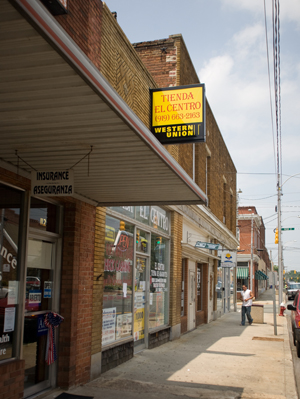
Chatham Ave. in downtown Siler City, N.C. Siler City and other cities like it are slowly working through conflict fueled by demographic changes.
In the summer of 2008, one of Siler City's two major chicken processing plants, Pilgrim's Pride, closed, costing the town more than 800 jobs. Some of the Latinos who'd held those jobs left town, but there was no mass exodus. Many Latinos have family members working in other industries besides chicken. They say they've put down roots in Siler City and hope to stay.
Nobody asserts that Siler City has solved its racial and ethnic tensions - not by a long shot. But many people in town, of all hues, express pride in how far their community has come, especially since the ominous day when David Duke came to town.
For the past several years, the national debate over immigration has been dominated by questions about undocumented, or illegal, immigrants. It's a legitimate policy debate, but Paul Cuadros maintains that it's driven by something else: the kind of demographic change and, ultimately, cultural change that Siler City and hundreds of other communities are working through, with varying degrees of success and conflict.
"You can deport all 12 million undocumented immigrants," Cuadros says, "but the demographic change is still going to happen. You know, 2050 is still going to happen."
The U.S. government recently updated its longstanding estimate that white Americans would become a minority in 2050. The government now says that's likely to happen sooner, around 2042.
"It's all about when the country becomes majority-minority," Cuadros says. "It becomes all mixed up. And that loss of power, numbers, whatever ... that frightens a lot of people. But change is inevitable. It's one of the physical laws of the universe. Nothing stays the same; everything changes. And that's a good thing."
Return to Pueblo USA
